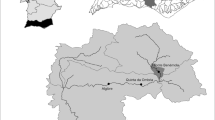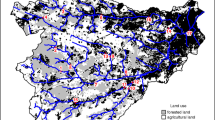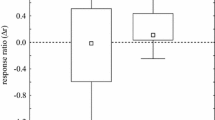Abstract
The upstream–downstream gradient (UDG) is a key feature of streams. For instance food webs are assumed to change from upstream to downstream. We tested this hypothesis in a small European river catchment (937 km2), and examined whether food web modifications are related to structural (i.e. food web composition) or functional changes (i.e. alteration of linkages within the web). We adopted a double approach at two levels of organisation (assemblage and species levels) using two isotopic metrics (isotopic space area and isotopic niche overlap), and proposed a new hypothesis-testing framework for exploring the dominant feeding strategy within a food web. We confirmed that the UDG influenced stream food webs, and found that food web modifications were related to both structural and functional changes. The structural change was mainly related to an increase in species richness, and induced functional modifications of the web (indirect effect). In addition, the UDG also modified the functional features of the web directly, without changing the web composition. The proposed framework allowed relating the direct effect of the UDG to a diet specialisation of the species, and the indirect effect via the structural changes to a generalist feeding strategy. The framework highlights the benefits of conducting the double approach, and provides a foundation for future studies investigating the dominant feeding strategy that underlies food web modifications.






Similar content being viewed by others
References
A.F.S. (American_Fisheries_Society) (2004) A.I.o.F.R.B. (American_Institute_of_Fishery_Research_Biologists), A.S.o.I.a.H. (American_Society_of_Ichtyologists_and_Herpetologists). Guidelines for the Use of Fishes in Research. American Fisheries Society, Bethesda, MA
Araújo M, Bolnick D, Layman C (2011) The ecological causes of individual specialisation. Ecol Lett 14:948–958. doi:10.1111/j.1461-0248.2011.01662.x
Arim M, Abades S, Laufer G, Loureiro M, Marquet P (2010) Food web structure and body size: trophic position and resource acquisition. Oikos 119:147–153. doi:10.1111/j.1600-0706.2009.17768.x
Bearhop S, Adams C, Waldron S, Fuller R, Macleod H (2004) Determining trophic niche width: a novel approach using stable isotope analysis. J Anim Ecol 73:1007–1012. doi:10.1111/j.0021-8790.2004.00861.x
Belliard J, Boët P, Tales E (1997) Regional and longitudinal patterns of fish community structure in the Seine river basin, France. Environ Biol Fish 50:133–147. doi:10.1023/A:1007353527126
Chang HY, Wu SH, Shao KT, Kao WY, Maa CJ, Jan RQ, Liu LL, Tzeng CS, Hwang JS, Hsieh HL, Kao SJ, Chen YK, Lin HJ (2012) Longitudinal variation in food sources and their use by aquatic fauna along a subtropical river in taiwan. Freshw Biol 57:1839–1853. doi:10.1111/j.1365-2427.2012.02843.x
Costas N, Pardo I (2014) Isotopic variability in a stream longitudinal gradient: implications for trophic ecology. Aquat Sci. doi:10.1007/s00027-014-0383-2
Gause G (1934) The struggle for existence. Williams and Wilkins, Baltimore
Hammerschlag-Peyer CM, Yeager LA, Araújo MS, Layman CA (2011) A hypothesis-testing framework for studies investigating ontogenetic niche shifts using stable isotope ratios. PLoS One 6:e27104. doi:10.1371/journal.pone.0027104
Hette-Tronquart N, Mazeas L, Reuilly-Manenti L, Zahm A, Belliard J (2012) Fish fins as non-lethal surrogates for muscle tissues in freshwater food web studies using stable isotopes. Rapid Commun Mass Spectrom 26:1603–1608. doi:10.1002/rcm.6265
Hoeinghaus D, Zeug S (2008) Can stable isotope ratios provide for community-wide measures of trophic structure? Comment. Ecol 89:2353–2357. doi:10.1890/07-1143.1
Holt R (1996) Food webs: integration of patterns and dynamics. Temporal and spatial aspects of food web structure and dynamics. Chapman & Hall, New York, pp 255–257
Ibañez C, Oberdorff T, Teugels G, Mamononekene V, Lavoué S, Fermon Y, Paugy D, Toham A (2007) Fish assemblages structure and function along environmental gradients in rivers of Gabon (Africa). Ecol Freshw Fish 16:315–334. doi:10.1111/j.1600-0633.2006.00222.x
Ibañez C, Belliard J, Hughes R, Irz P, Kamdem-Toham A, Lamouroux N, Tedesco P, Oberdorff T (2009) Convergence of temperate and tropical stream fish assemblages. Ecograph 32:658–670. doi:10.1111/j.1600-0587.2008.05591.x
Jackson A, Inger R, Parnell A, Bearhop S (2011) Comparing isotopic niche widths among and within communities: siber-stable isotope bayesian ellipses in R. J Anim Ecol 80:595–602. doi:10.1111/j.1365-2656.2011.01806.x
Jackson MC, Donohue I, Jackson AL, Britton JR, Harper DM, Grey J (2012) Population-level metrics of trophic structure based on stable isotopes and their application to invasion ecology. PLoS One 7:e31757. doi:10.1371/journal.pone.0031757
Jepsen D, Winemiller K (2002) Structure of tropical river food webs revealed by stable isotope ratios. Oikos 96:46–55. doi:10.1034/j.1600-0706.2002.960105.x
Layman C, Arrington D, Montaña C, Post D (2007) Can stable isotope ratios provide for community-wide measures of trophic structure? Ecol 88:42–48. doi:10.1890/0012-9658(2007)88[42:CSIRPF]2.0.CO;2
Layman C, Araújo M, Boucek R, Hammerschlag-Peyer C, Harrison E, Jud Z, Matich P, Rosenblatt A, Vaudo J, Yeager L, Post D, Bearhop S (2012) Applying stable isotopes to examine food-web structure: an overview of analytical tools. Biol Rev 87:545–562. doi:10.1111/j.1469-185X.2011.00208.x
MacArthur RH, Pianka ER (1966) On optimal use of a patchy environment. Am Nat 100:603–609
MacGarvey D, Hughes R (2008) Longitudinal zonation of pacific northwest (U.S.A.) fish assemblages and the species-discharge relationship. Copeia 2:311–321. doi:10.1643/CE-07-020
Mason N, Lanoiselée C, Mouillot D, Wilson J, Argillier C (2008) Does niche overlap control relative abundance in french lacustrine fish communities? A new method incorporating functional traits. J Anim Ecol 77:661–669. doi:10.1111/j.1365-2656.2008.01379.x
Matthews W (1998) Patterns in freshwater fish ecology. Kluwer Academic Publishers, Norwell
Minns CK (1995) Allometry of home range size in lake and river fishes. Can J Fish Aquat Sci 52:1499–1508
Newsome S, Del Rio C, Bearhop S, Phillips D (2007) A niche for isotopic ecology. Front Ecol Environ 5:429–436. doi:10.1890/1540-9295(2007)5[429:ANFIE]2.0.CO;2
O’Neil B, Thorp J (2014) Untangling food-web structure in an ephemeral ecosystem. Freshw Biol 59:1462–1473. doi:10.1111/fwb.12358
Oberdorff T, Guilbert E, Lucchetta JC (1993) Patterns of fish species richness in the Seine river basin, France. Hydrobiol 259:157–167. doi:10.1007/BF00006595
Oberdorff T, Pont D, Hugueny B, Chessel D (2001) A probabilistic model characterizing riverine fish communities of French rivers: a framework for environmental assessment. Freshw Biol 46:399–415. doi:10.1046/j.1365-2427.2001.00669.x
Oberdorff T, Pont D, Hugueny B, Porcher J (2002) Development and validation of a fish-based index for the assessment of ‘river health’ in France. Freshw Biol 47:1720–1734. doi:10.1046/j.1365-2427.2002.00884.x
Petts G, Calow P (1996) River biota: diversity and dynamics. Blackwell Science, Oxford
Post D, Takimoto G (2007) Proximate structural mechanisms for variation in food-chain length. Oikos 116:775–782. doi:10.1111/j.2007.0030-1299.15552.x
Post D, Layman C, Arrington D, Takimoto G, Quattrochi J, Montaña C (2007) Getting to the fat of the matter: models, methods and assumptions for dealing with lipids in stable isotope analyses. Oecologia 152:179–189. doi:10.1007/s00442-006-0630-x
Power M, Dietrich W (2002) Food webs in river networks. Ecol Res 17:451–471. doi:10.1046/j.1440-1703.2002.00503.x
Rasmussen J, Trudeau V, Morinville G (2009) Estimating the scale of fish feeding movements in rivers using δ13C signature gradients. J Anim Ecol 78:674–685. doi:10.1111/j.1365-2656.2008.01511.x
Rice S, Greenwood M, Joyce C (2001) Tributaries, sediment sources, and the longitudinal organisation of macroinvertebrate fauna along river systems. Can J Fish Aquat Sciences 58:824–840. doi:10.1139/cjfas-58-4-824
Sabo J, Finlay J, Kennedy T, Post D (2010) The role of discharge variation in scaling of drainage area and food chain length in rivers. Science 330:965–967. doi:10.1126/science.1196005
Sedell J, Richey J, Swanson F (1989) The river continuum concept: a basis for the expected ecosystem behaviour of very large rivers? Can Spec Publ Fish Aquat Sci 106:49–55
Semmens B, Ward E, Moore J, Darimont C (2009) Quantifying inter-and intra-population niche variability using hierarchical bayesian stable isotope mixing models. PLoS One 4. doi:10.1371/journal.pone.0006187
Syväranta J, Lensu A, Marjomäki T, Oksanen S, Jones R (2013) An empirical evaluation of the utility of convex hull and standard ellipse areas for assessing population niche widths from stable isotope data. PLoS One 8. doi:10.1371/journal.pone.0056094
Thompson R, Brose U, Dunne J, Hall R, Hladyz S, Kitching R, Martinez N, Rantala H, Romanuk T, Stouffer D, Tylianakis J (2012) Food webs: reconciling the structure and function of biodiversity. Trends Ecol Evol 27:689–697. doi:10.1016/j.tree.2012.08.005
Tomanova S, Tedesco P, Campero M, Van Damme P, Moya N, Oberdorff T (2007) Longitudinal and altitudinal changes of macroinvertebrate functional feeding groups in neotropical streams: a test of the river continuum concept. Fundam Appl Limnol 170:233–241. doi:10.1127/1863-9135/2007/0170-0233
Townsend C, Hildrew A (1994) Species traits in relation to a habitat templet for river systems. Freshw Biol 31:265–275
Vander Zanden M, Rasmussen J (1999) Primary consumer δ13C and δ15N and the trophic position of aquatic consumers. Ecol 80:1395–1404
Vannote R, Minshall G, Cummins K, Sedell J, Cushing C (1980) The river continuum concept. Can J Fish Aquat Sci 37:130–137
Verneaux J, Schmitt A, Verneaux V, Prouteau C (2003) Benthic insects and fish of the doubs river system: typological traits and the development of a species continuum in a theoretically extrapolated watercourse. Hydrobiol 490:63–74. doi:10.1023/A:1023454227671
Werner R, Brand W (2001) Referencing strategies and techniques in stable isotope ratio analysis. Rapid Commun Mass Spectrom 15:501–519. doi:10.1002/rcm.258
Winemiller K, Hoeinghaus D, Pease A, Esselman P, Honeycutt R, Gbanaador D, Carrera E, Payne J (2011) Stable isotope analysis reveals food web structure and watershed impacts along the fluvial gradient of a mesoamerican coastal river. River Res Appl 27:791–803. doi:10.1002/rra.1396
Wootton J (1994) Predicting direct and indirect effects: an integrated approach using experiments and path analysis. Ecol 75:151–165
Acknowledgments
Grateful acknowledgment is expressed to HEF team (part of Hydrosystems and Bioprocesses Research Unit at Irstea Antony) for assistance in the field and sample preparation. We thank Adrien Rey and the regional natural park “Parc Naturel Régional de la haute vallée de Chevreuse” for advice and participation to field work. Olivier Delaigue gave helpful recommendations for statistical analyses. Michel Hénin, head of the RGIS department at the “Institut d’Aménagement et d’Urbanisme d’île-de-France’’ kindly provided the land cover data. We thank the anonymous reviewers, who helped improve the previous versions of this manuscript. This work was partly funded by the Interdisciplinary Research Program on the Seine River Environment (PIREN-Seine—http://www.sisyphe.upmc.fr/piren/) and by the project 33 of the framework agreement between Irstea and the French National Agency for Water and Aquatic Environments (ONEMA).
Author information
Authors and Affiliations
Corresponding author
Electronic supplementary material
Below is the link to the electronic supplementary material.
Rights and permissions
About this article
Cite this article
Hette-Tronquart, N., Belliard, J., Tales, E. et al. Stable isotopes reveal food web modifications along the upstream–downstream gradient of a temperate stream. Aquat Sci 78, 255–265 (2016). https://doi.org/10.1007/s00027-015-0421-8
Received:
Accepted:
Published:
Issue Date:
DOI: https://doi.org/10.1007/s00027-015-0421-8




